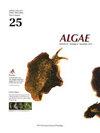Effect of substratum types on the growth of assimilators and stolons of Caulerpa okamurae (Bryopsidales, Chlorophyta)
IF 2.4
3区 生物学
Q1 MARINE & FRESHWATER BIOLOGY
引用次数: 0
Abstract
To examine the effects of substratum types on the growth of Caulerpa okamurae, sand surface and sand burial experiments were conducted. Five assimilators (erect fronds) per replicate were cultured for 15 d on the surface of three different treatments: fine sand (200 μm), coarse sand (600 μm), and no sand (control). Also, three stolons and three assimilators were buried by fine grain or coarse grain sands and incubated for 15 d. In both experiments, other culture conditions included 25°C, 30 μmol photons m-2 s-1, and 16 : 8 h L : D (light : dark). In both experiments, stolon + assimilator-, assimilator-, and stolon-weights were measured. Relative growth rates (RGRs) of stolon + assimilator weights ranged from 0.43 to 1.95% d-1 at no sand and fine sand treatment, respectively. RGRs for the weight of stolon + assimilator and new assimilators were significantly greater on the fine- and coarse sand surface than the control. In the burial experiments, RGRs of stolons (4.28% d-1 at coarse sand and 5.57% d-1 at fine sand, respectively) were significantly greater than those of assimilators (1.38% d-1 at fine sand and 1.82% d-1 at coarse sand, respectively). When stolons were buried, RGRs for assimilators were greater at the fine sand than at the coarse sand treatment. On the other hand, RGRs of buried assimilators for total frond weights and for newly produced stolons were significantly greater at the coarse sands than at the fine sands. In conclusion, C. okamurae grew well with all substrates of sands and showed better growth on fine sands than coarse ones. This result suggests that the growth of stolons and assimilators of C. okamurae is stimulated after stable attachment to the sand substrates by rhizophores. In addition, stolons showed higher growth rates than the assimilators in the sand burial states, indicating that stolons are more tolerant to low light than assimilators of C. okamurae.不同基质类型对冈野茎叶同化物和匍匐茎生长的影响
为了研究不同基质类型对冈村Caulpa okamura生长的影响,进行了砂面和砂埋试验。在细沙(200μm)、粗砂(600μm)和无沙(对照)三种不同处理的表面上,每个重复培养5个同化物(直立叶)15天。此外,三个匍匐茎和三个同化物被细粒或粗粮沙掩埋并孵育15天。在两个实验中,其他培养条件包括25°C、30μmol光子m-2 s-1和16:8 h L:d(光:暗)。在两个实验中,都测量了匍匐茎+同化物、同化物和匍匐茎的重量。在无砂和细沙处理下,匍匐茎+同化物重量的相对生长率(RGRs)分别为0.43%至1.95%d-1。细沙和粗砂表面匍匐茎+同化物和新同化物重量的RGRs显著大于对照。在埋藏实验中,匍匐茎的RGR(粗砂中分别为4.28%d-1和细沙中分别为5.57%d-1)显著大于同化物的RGR,细沙中为1.38%d-1,粗砂中为1.82%d-1)。当匍匐茎被掩埋时,同化物的RGR在细沙处理时大于在粗砂处理时。另一方面,埋藏同化物对总叶重和新产生匍匐茎的RGR在粗砂中明显大于在细沙中。总之,C.okamura在所有沙子基质中生长良好,在细沙子上的生长比在粗沙子上的好。这一结果表明,在发根细胞稳定附着在沙基质上后,冈村C.okamura匍匐茎和同化物的生长受到刺激。此外,在沙埋状态下,匍匐茎比同化物表现出更高的生长速率,这表明匍匐茎比冈村C.okamurae的同化物更耐弱光。
本文章由计算机程序翻译,如有差异,请以英文原文为准。
求助全文
约1分钟内获得全文
求助全文
来源期刊

Algae
PLANT SCIENCES-
CiteScore
5.10
自引率
25.00%
发文量
18
期刊介绍:
ALGAE is published by the Korean Society of Phycology and provides prompt publication of original works on phycology. ALGAE publishes articles on all aspects of phylogenetics and taxonomy, ecology and population biology, physiology and biochemistry, cell and molecular biology, and biotechnology and applied phycology. Checklists or equivalent manu-scripts may be considered for publication only if they contribute original information on taxonomy (e.g., new combinations), ecology or biogeography of more than just local relevance. Contributions may take the form of Original Research Articles, Research Notes, Review Articles and Book Reviews.
 求助内容:
求助内容: 应助结果提醒方式:
应助结果提醒方式:


